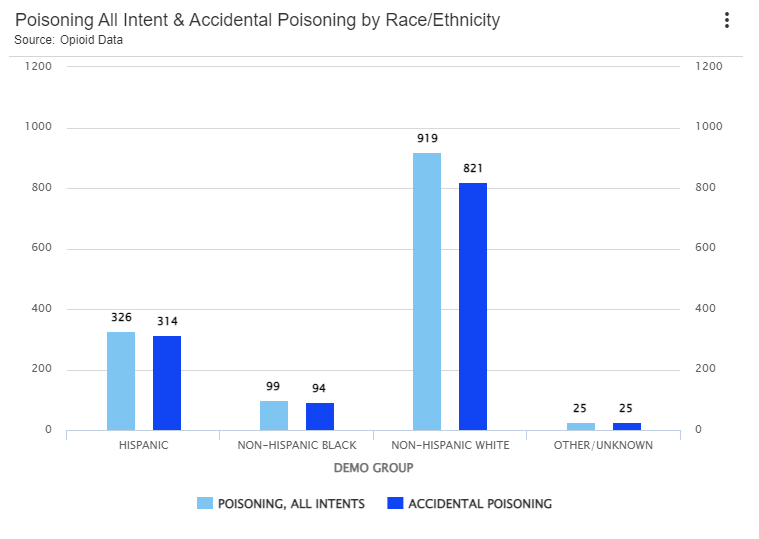Opioid Use in Texas
What Are Opioids?

Opioids form a class of drug that includes powerful pain medications, such as oxycodone, morphine, and fentanyl. The illegal drug heroin is also an opioid. Some opioids are derived from opium poppies, while others are synthetic.
Increasingly, fentanyl and other synthetic opioids are illegally manufactured and distributed alongside or mixed with heroin. Many opioid-related deaths involve more than one type of drug.
Doctors prescribe opioids because the drugs are highly effective as painkillers. But they are also highly addictive.
In this dashboard, we will highlight where Texas stands in relation to the the rest of the nation by looking at the number of deaths and other demographics that show the prevalence of what could be a rise in opioid use in Texas.

Opioid Use by Demographics
Opioid Use by Demographics

In general, males suffer more from all opioid poisonings, including accidental opioid poisonings, compared to females.

More opioid poisonings, including accidental opioid poisonings, occur among Non-Hispanic White and Hispanic individuals compared to other race/ethnic groups.

Most opioid poisoning, including accidental opioid poisoning, occur in the 18-44 age group.

Most opioid poisoning, including accidental opioid poisoning, occur in the high school or less educational attainment group.
How Did The Crisis Begin?
How Did The Crisis Begin?
Many experts trace the roots of the opioid crisis to the overprescription of opioid pain relievers, beginning in the late 1990’s. Health experts now recognize that prescription opioids are dangerously addictive. Many doctors have taken steps to limit opioid prescriptions, and prescription rates have decreased every year since 2010.
But legal prescription opioids are just one side of the epidemic. Even as the prescription opioid supply is constrained, the illegal supply has rapidly expanded to meet the demand. Heroin and black-market fentanyl are often cheaper and more accessible than legal prescription opioids. Studies have shown that prescription opioid use is a strong predictor of later heroin use: three out of four new heroin users have reported previously abusing prescription opioids.

Combating the Opioid Crisis
 Medication Assisted Treatment (MAT) is an important treatment options for many facing opioid addiction. MAT uses medications in combination with counseling and other behavioral therapies.
Medication Assisted Treatment (MAT) is an important treatment options for many facing opioid addiction. MAT uses medications in combination with counseling and other behavioral therapies.
Source: AmfAR’s Opioid & Health Indicators Database

Buprenorphine is one of the three drugs approved by the FDA for the treatment of opioid addiction and is often a part of MAT and fall under many products such as Bunavail and Probuphine. The other two drugs approved by the FDA are methadone and naltrexone.
Source: AmfAR’s Opioid & Health Indicators Database
About the Data
What are opioids: Data are from the National Center of Health Statistics and the Texas Health Care Information Council.
Metro and Nonmetro Overdose Deaths: Rural Health Information Hub
Overdose Deaths per 100,000 for Metro and Nonmetro Counties, 1999-2016 – Texas
Overdose Deaths per 100,000, 2016 – Texas
How Did The Crisis Begin: Data are from the Centers for Disease Control and Prevention’s (CDC) U.S. Opioid Dispensing Rate Maps .
Combating the Opioid Crisis: Data are from amfAR’s Opioid & Health Indicators Database.


